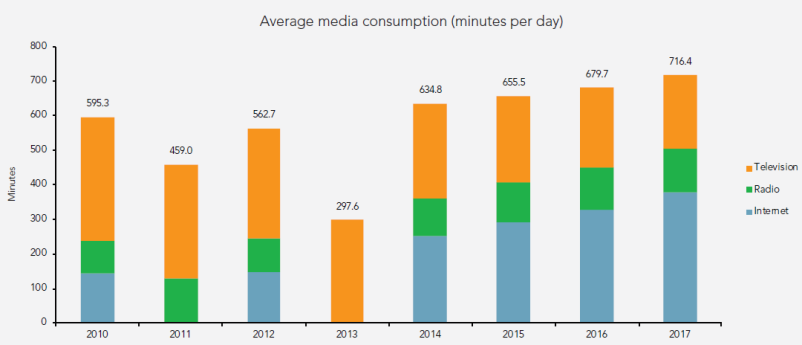Zenith’s Media Consumption Forecasts has painted an interesting picture for media consumption pattern in the Middle East and North Africa (MENA) region. For most marketers in the region, television continues to be a medium of significance. The report however has shown a marked decline in time spent on television. Not surprisingly a parallel increase is seen on the internet, which since 2015 has taken over television to become the lead medium.
Given data constrictions, Zenith’s Media Consumption Forecasts has looked at only three media in various markets in the region – television, radio and internet. Television is the only medium that has shown decline among these. From around 250 average minutes per day spent on television in 2015, by 2018, the number will decline to 198 minutes per day that a consumer will spend on TV. Zenith clarifies that this is the traditional form of television. Since most broadcasters now also have extensive online presence, the loss of time on traditional TV does not directly implicate lower popularity of broadcast players and their content. Some traditional television players have also claimed larger audiences online than they ever had for their offline products.
The growth and growth story belongs to internet. From approximately 290 minutes spent on the internet per day, Zenith expects consumers in the region to spend 389.2 minutes on an average with the medium.
The amount of time people around the world devote to using mobile internet will increase by 27.7 percent this year, driving a 1.4 percent increase in overall media consumption. The consumption of all other media – including desktop internet – will decline, by 3.4 percent in total. Conventional wisdom and trends from other sources would indicate that for some markets in MENA as well, mobile internet will be the growth driver. The expansion of mobile internet consumption is an opportunity for traditional publishers and broadcasters, as much as a threat.
Radio listening is also showing an increase in consumption. The trends have led to a much narrower gap between TV and print over an eight-year period.

The overall increase in the time spent across the mentioned media is another reason that makes Zenith’s observations interesting. From a total of 634.8 minutes spent across television, radio and internet in 2014, consumers will spend a total of 716.4 minutes engaging with these mediums by 2018. While the obvious reason is the fact that the decline in television is not as steep as the growth in internet or even in radio, it must also be noted that this indicates the growth in content creation across the three mediums that the region has been witnessing. The dual effect of the increase in connectivity and increase in available content is further fuelling the time spent patterns.
This is the second annual edition of Zenith’s Media Consumption Forecasts, which surveys changing patterns of media consumption, and assesses how the amount of time people allocate to different media will change between 2016 and 2018. Globally, the report looks at the amount of time spent reading newspapers and magazines, watching television, listening to the radio, visiting the cinema, using the internet, and viewing outdoor advertising while out of the home. This edition covers 71 countries across the world, up from 65 last year.
Global Takeaways
Desktop internet consumption grew rapidly in the early years of this decade, peaking at 52 minutes a day in 2014, up from 36 minutes a day in 2010. Globally however, desktop consumption is now in decline as users switch to mobile devices. In 2015 mobile overtook desktop to become the primary means of accessing the internet, and this year we forecast that people across the world will spend on average 86 minutes a day using mobile internet, compared to 36 minutes using desktop internet. This means that 71 percent of internet consumption will be via mobile. The region most heavily skewed towards mobile internet consumption is Asia Pacific, where 73 percent of internet consumption is mobile, closely followed by North America, where the mobile share is 72 percent.
Mobile internet consumption is growing at the expense of all other media. Zenith forecasts that the average time spent with mobile internet globally will grow 27.7 percent this year, while time spent with desktop internet will fall 15.8 percent. All traditional media will shrink this year: cinema by 0.5 percent, outdoor by 0.8 percent, television by 1.5 percent, radio by 2.4 percent, newspapers by 5.6 percent and magazines by 6.7 percent.
“Mobile technology is transforming the way people around the world consume media, and is expanding overall media consumption. It provides traditional media owners the opportunity to reach people and places they’ve never had access to previously, and gives consumers entirely new ways to find and enjoy compelling content,” said Jonathan Barnard, Zenith’s Head of Forecasting.





